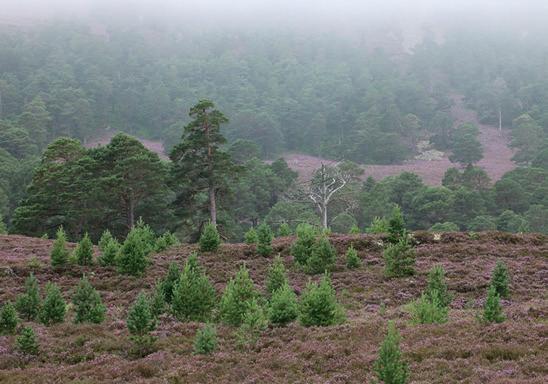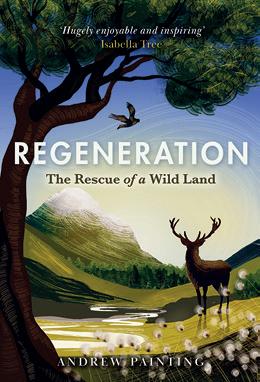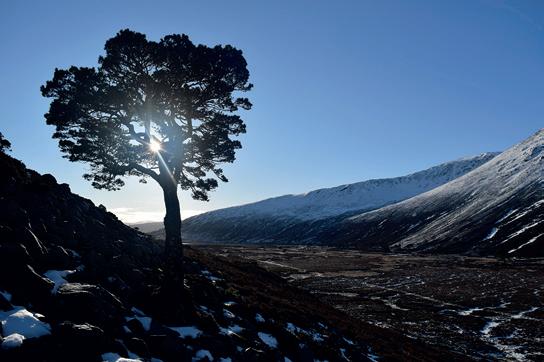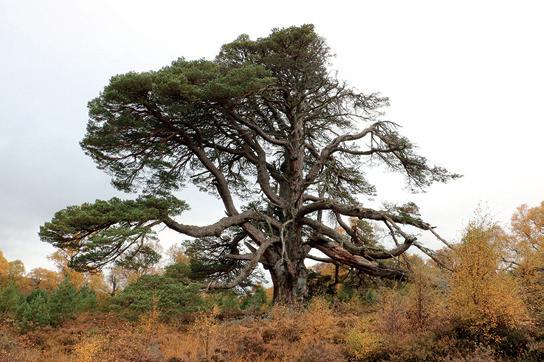
4 minute read
The 60,000 tree woman
A dozen years ago, ecologist Shaila Rao’s strategy of restoring Mar Lodge Estate through extensive deer culls was widely criticised. In the first of a series of edited extracts from his new book, Andrew Painting shows why she has had the last laugh.

Advertisement
paste that threatened to leach into the interior workings of the computer.
It is meticulous work, but she works quickly, and it takes a lot of concentration to keep up with her. After eighteen years of monitoring, Shaila has around 60,000 tree-height measurements, and hundreds of thousands of individual pieces of data.
Sheila is the estate ecologist: the in-house go-to person for all things ecological. It’s her job to provide the science that informs management decisions on the ground. Since 2002, she has been the driving force behind some of the more remarkable recent changes to the Mar Lodge woodlands. Among many other things, she has been counting and measuring tree seedlings in seventeen quadrats (10 metre x 10 metre squares) strewn across the woods. Today’s quadrat is in Glen Derry, on the edge of the pinewood, with a frankly phenomenal view of the pines stretching out towards Derry Cairngorm and Beinn Mheadhoin.

In 1995, the Trust embarked on its plan to save the pinewood. The number of deer would be drastically reduced to give the woods a chance to regenerate. This plan would be in harmony with the wider sporting interests of the estate. Environmentalists eagerly awaited the revival of the pinewood. Sporting interests also watched on, some curious, some excited, some concerned that the grand scheme would bring about the end of their way of life, and their income.
It quickly became clear that landscape-scale deer reduction was not a simple task. After seven years of controversial deer management there was little sign of the woodland recovering. In 2002, the average size of the seedlings in her quadrats was 9 centimetres. As soon as they grew above the height of nearby vegetation they were chomped back again.
Shaila watched this happen for five years. ‘It was desperate. It was totally frustrating because you were setting up monitoring, providing information, showing that the majority of seedlings were being quite heavily damaged, but we weren’t seeming to respond to that in terms of management. In the quadrats it could take an hour just to count the deer dung.
I used to look up and see a group of deer sitting above me, watching me work.’
Back in 1998, to complement annual surveys, 3.7 hectares of woodland were monitored in extremely close detail. Just four seedlings were recorded above the height of the adjacent vegetation. The 2008 survey noted worrying mortality levels in mature pine trees, while there were 10 per cent fewer birches. At the rates of growth recorded, the pinewoods could well be lost.
After a decade of controversial management and little to show for it, the period from 2008 to 2012 was a difficult one at Mar Lodge. Ecologically, things had been so bad for so long that a concerted effort to clear the woods of all but a token presence of deer was needed to give the trees the fighting chance they needed. But as deer numbers were reduced, the lack of competition and improving food source created a vacuum that sucked in deer from neighbouring estates.
‘It was a stormy period of time,’ says Shaila. ‘When I look back, it was awful. There was a kickback from some of the neighbouring estates, and internally there was mixed feeling about the policy. Some people felt it was futile that we were shooting all these deer when there was nothing to show for it. And part of it was about the manner in which we were killing deer, and not putting up fencing [this had been tried in the 1990s but was found responsible for the deaths of several capercaillie who flew into it]. We had two or three meetings in the village where you could have cut the air with a knife. It was very unpleasant for the people working here.’
In 2011, buffeted from all sides, the Trust decided to undertake an independent review of their management. This took evidence from staff, neighbouring estates, the local community and conservation experts about how Mar Lodge was being managed. It did not make for particularly comfortable reading.
New strategies were implemented. The fourkilometre-long, off-set electric fence recommended by the review was installed: in the woods, two parallel, low fences which would be too wide for deer to jump over, wouldn’t kill woodland grouse, and would allow the movement of other creatures. It showed that the Trust was capable of listening to criticism and willing to work collaboratively. In 2012, the little bar on Shaila’s graph topped 25 centimetres.
Yet by 2015 Shaila’s graphs were beginning to look respectable. In fact, the trees had nearly doubled in size since 2012. By 2016, twenty years after the Trust took on the estate, the tide had turned. A detailed survey that year found 835 hectares of regenerating woodland: the Caledonian pinewood was set to double in size. In 2017, the estate was designated a National Nature Reserve. By 2019, the average height of trees in Shaila’s plots was tipping 80 centimetres, with the tallest pines topping 2.5 metres. Many of these had shot up since 2008 – new seedlings, unencumbered by grazing, growing faster than the original seedlings which had survived –just – decades of nibbling. Trees grew more on average in one year between 2018 and 2019 than in the six between 2002 and 2008.

By 2019, it wasn’t just the pines. Birches, rowans, willows and juniper were growing vigorously. Orchids, lesser and common twayblade, small white orchid, frog orchid, were beginning to appear in places they hadn’t been recorded before. Wildflowers which were rare a decade ago were becoming almost commonplace: alpine meadow-rue, globeflower, Scottish asphodel. There was more heather, more blaeberry, more wildflower species. Lesser twayblade, one of my favourite orchids, had increased by 233 per cent. Wood ant nests had changed shape to cope with the increase in vegetation height, becoming on average 55 per cent taller over twenty years. Deadwood was accumulating, providing habitat for more insects, and nesting sites for more birds.
This is exactly what the conservationists demanding a reduction in deer numbers twenty-five years before had said would happen. And yet to see it happen is a bit of a shock. This is ecological processes unfolding on a landscape scale. It is nothing less than the mechanics of the universe writ large across thousands of hectares of land. It is all rather beautiful.









